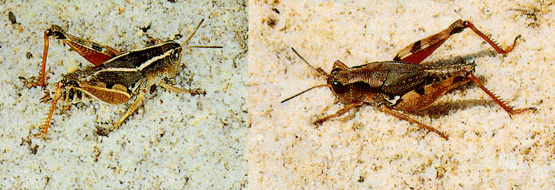Description
The wingless grasshopper adult is 13-18mm long and has two forms, with or without a pair of white stripes on each side of the thorax (see Figure 1). Most adults have short, undeveloped wings but small numbers of the population can have functional wings and are capable of considerable wind-assisted flight.
Newly-emerged wingless grasshoppers are less than 2mm long and are a uniform dark grey (see Figure 6). The identification of these hatchlings is an important part of any control program and growers would be wise to ensure that they can recognise wingless grasshoppers at this stage of their development. There are two colour forms of the wingless grasshopper shown in the image below.


